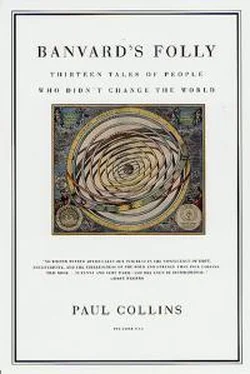For an account of the "party invitation" hoax played on Coates, see the 1862
volume of The St. James' Magazine, pp. 488-89. A brief overview of Coates's
life is also to be found in the August 19, 1865, issue of London's Once a Week magazine, pp. 232-37.
AUGUSTUS J. PLEASONTON
As so often happens, this chapter came about by accident. I was loitering around the stacks of old books in the basement of the University of California at San Francisco library, this being my wont, simply plucking random books off the shelves and flipping them open. Victorian hydrotherapy books, 1868
treatises on dental sugery, and all kinds of turn-of-the-century strangeness: The Milk Diet, or Good Health: By One Who Has It, or Viavi Hygiene ... and a beautiful little blue book caught my eye. That's when it all started.
Without question, the first book to seek out is this masterpiece of eccentricity by A. J. Pleasonton, The Influence of the Blue Ray of the Sunlight and the Blue Colour of the Sky (1876, 1877); there are copies at the Library of Congress, the New York Public Library, and major research libraries like those at UC Berkeley and UC San Francisco. It is worth possessing, really, although any antiquarian dealer lucky enough to have one will surely charge you upwards of $200 for a tight copy.
The other books around the blue glass movement are harder to find: John Carboy's Blue Glass a Sure Cure for the Blues (1877) is on microfilm at UC
Berkeley, and the original copy is in the Rare Book Room of the Huntington Library in Los Angeles. The Library of Congress has Henry Beidler's Blue Glass Sun-Baths as a Curative (1877) and Thomas Gaffield's The Action of Sunlight on Glass (1881). Edward Mack's Blue Glass March is in the Rare Book Collection at the University of Pennsylvania library. Thomas Gaffield's The Blue Glass Mania (1877) is at the National Library of Medicine (national Institutes of Health) in Bethesda, Maryland. Josh Billings' Trump Kards: Blue Glass Philosophy can be found at the Bancroft Library at UC Berkeley. Seth Pancoast's Blue and Red Light: Or, Light and Its Rays as Medicine (1877) and Edwin Babbitt's The Principles of Light and Color (1878) are also at UC San Francisco, and Babbit's book was even reissued in a 1967 abridgment with annotations by the twentieth century color enthusiast Faber Birren.
There were a number of periodical articles about the craze, including Scientific American in 1877: February 24, March 3, 10, 17, 24, April 7, June 23, and July 7; and Medical and Surgical Reporter in 1876: April 22, August 5; and in 1877: April 7, 14, and November 24. The Manufacturer and Builder had scathing commentary in August 1871, June 1876, March 1877, June 1877, and June 1879. Harper's New Monthly had an item on colored light experiments in April 1870, and the London Times carried a brief notice of blue glass treatments on February 20, 1877. Finally, the poem "The Scientific Housewife" is taken from the July 2, 1895, issue of The Railway Surgeon.
As for modern articles on Pleasonton or blue glass, save your time: there aren't any. The last word on Pleasonton came with the London Times obituary on August 1, 1894; just the year before, Cyrus Edson was already nostalgically speaking of blue glass in his March 1893 article "Fads of Medicial Men" in the North American Review. The final word written at all on blue glass seems to be in Henry Collins Brown's Valentine's Manual of Old New York 1926 (1926). The Valentine's series is wonderfully written and prolific enough to be had cheaply from antiquarian dealers. Anyone professing an interest in the nineteenth century or in New York City should buy a shelfload.
Details about the colorful fraud Dinshah Ghadali can be found among the droll wit of Nostrums and Quackery, last published by the American Medical Association in 1936. The AMA put out a series of corrosive pamphlet attacks on charlatans early in the century, and these supplied my information on
Chichester pills and "Doctor" Campbell: "Female Weakness" Cures and Allied Frauds (1915) and Some Quasi-Medical Insitutions (1916), both available at the University of Califonria at San Francisco. There are also many later light therapy texts there, including Phototherapy (1901) by Niels Finsen, Light Energy (1904) by Margaret Cleaves, Light Therapeutics by J. H. Kellogg (1910), Sunlight and Health (1924) by C. W. Saleeby, and The Seven Keys to Colour Healing (1940) by Roland Hunt. Dr. Gerald Weissman's excellent Democracy and DNA (1995) provides useful contextual medical history, and Dr. Weissman very kindly helped me find research papers on modern UV therapies.
DELIA BACON
You're best off sticking with the original nineteenth-century sources.
Bacon's Philosophy of the Plays of Shakespere Unfolded (1857) is reissued by an academic press every few decades or so, and so it's not too hard to find copies around. Used copies tend to be suspiciously pristine in condition.
Her earlier works make for much more pleasant reading. Tales of the Puritans (1831) and The Bride of Fort Edward (1839) can be found on microfilm in many libraries; the University of California at Berkeley also has original hardcover copies of both books. Catharine Beecher's "favor" to Delia, Truth Stranger than Fiction (1850), is much harder to find in print, but many libraries have it on microfilm.
The standard biography of Bacon is Prodigal Puritan (1959) by Vivian Hopkins; its style is a bit creaky, but it is well researched. Of the earlier commentaries on Bacon's life, the best two are probably Nathaniel Hawthorne's appreciation "Recollections of a Gifted Woman" in the January 1863 issue of The Atlantic Monthly, which was then reprinted in his collection Our Old Home, and Theodore Bacon's Delia Bacon: A Biographical Sketch (1888). The latter is difficult to find, but well worth it for the wealth of primary documents that it reprints. The San Francisco Public Library has a copy. And in a class all its own is Ignatius Donnelly's 998-page magnum loco opus --if you do not count his work on the lost city of Atlantis--The Great Cryptogram (1888).
And regarding the creepy Hodie mihi, cras tibi epitaph--you can see one in the graveyard of Greyfriars Church, in Edinburgh. Go on an especially cold and rainy day.
THOMAS DICK
The Complete Works of Thomas Dick (1856) contains crucial works like Celestial Scenery, The Solar System, and The Sidereal Heavens. There are numerous nineteenth century reprints of William Paley's primer Natural Theology (1802). The equally important Bridgewater Treatise (1836) by William Whewell might be harder to find, even though it went through at least ten editions. A different slant is provided by Sir David Brewster's On the Plurality of Worlds (1854), and a last gasp of natural astronomy turns up in J. W. Fring's God in the Universe (1914).
Richard Locke's hoax "Great Astronomical Discoveries Lately Made by Sir John Herschel at the Cape of Good Hope" (1835) has been reproduced on the web site
"Moon Walk 1835," at http://users.visi.net/cwt/ moonwalk.html. It's a crime
that someone hasn't reprinted Locke's sci-fi classic. Modern accounts of the hoax can also be found in the book To the Moon (1968), by Hamilton Wright et also., and in the April 1969 issue of American Heritage magazine.
My chapter here only scratches one surface of natural theology and pluralistic worlds. For a much deeper account, I highly recommend Michael Crowe's The Extraterrestrial Life Debate, 1750-1900 (1986); it is a work of impeccable
scholarship. A new reprint of Crowe also mentions the recent completion of an Oxford University doctoral dissertation, "Observing God: Thomas Dick (1774-1857), Evangelism, and Popular Science in Victorian Britain and Antebellum America" by William Astore; I have not laid my hands on a copy of this dissertation yet, but any future writer on Dick probably should.
Читать дальше











